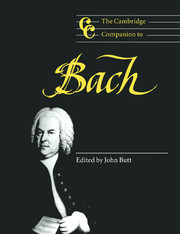Book contents
- Frontmatter
- Introduction
- Part I The historical context: society, beliefs and world-view
- Part II Profiles of the music
- 6 The early works and the heritage of the seventeenth century
- 7 The mature vocal works and their theological and liturgical context
- 8 The instrumental music
- 9 The keyboard works: Bach as teacher and virtuoso
- 10 Composition as arrangement and adaptation
- 11 Bachian invention and its mechanisms
- Part III Influence and reception
- Notes
- Select bibliography
- General Index
- Index of works
7 - The mature vocal works and their theological and liturgical context
from Part II - Profiles of the music
Published online by Cambridge University Press: 28 September 2011
- Frontmatter
- Introduction
- Part I The historical context: society, beliefs and world-view
- Part II Profiles of the music
- 6 The early works and the heritage of the seventeenth century
- 7 The mature vocal works and their theological and liturgical context
- 8 The instrumental music
- 9 The keyboard works: Bach as teacher and virtuoso
- 10 Composition as arrangement and adaptation
- 11 Bachian invention and its mechanisms
- Part III Influence and reception
- Notes
- Select bibliography
- General Index
- Index of works
Summary
Many superlatives have been lavished on Bach's mature vocal works, such as Georg Nägeli's acclamation of the B minor Mass as one of the ‘greatest musical works of art of all times and of all peoples’, or Mendelssohn's veneration of the Matthew Passion as ‘the greatest of Christian works’. But such evaluations have usually been based on the concept that these incomparable works of Bach are self-standing musical monuments. Following Mendelssohn's revival of the Matthew Passion in 1829, Bach's cantatas, oratorios, passions, Magnificat and the B minor Mass have generally been performed as autonomous works in a concert setting. But this later usage was not what the composer envisaged. What Robert Marshall writes with regard to the cantatas applies equally to most of Bach's other vocal works: ‘such compositions were not intended primarily for the “delectation” of a concert public, but rather for the “edification” of a church congregation … Bach's cantatas, in fact, were conceived and should be regarded not as concert pieces at all but as musical sermons; and they were incorporated as such in the regular Sunday church services.’ This chapter therefore discusses these works against the background of the liturgical imperatives that brought them into being.
Liturgy and music in Leipzig
The specific liturgical practices of Leipzig provide the immediate context for the creation of Bach's mature vocal works. Liturgical usage in Leipzig during the eighteenth century was somewhat conservative. Compared with other areas of Germany, where traditional Lutheran liturgical forms, based on Luther's two liturgies, were already beginning to be eroded, Leipzig retained a highly developed and rich liturgical and musical tradition.
- Type
- Chapter
- Information
- The Cambridge Companion to Bach , pp. 86 - 122Publisher: Cambridge University PressPrint publication year: 1997
- 1
- Cited by



